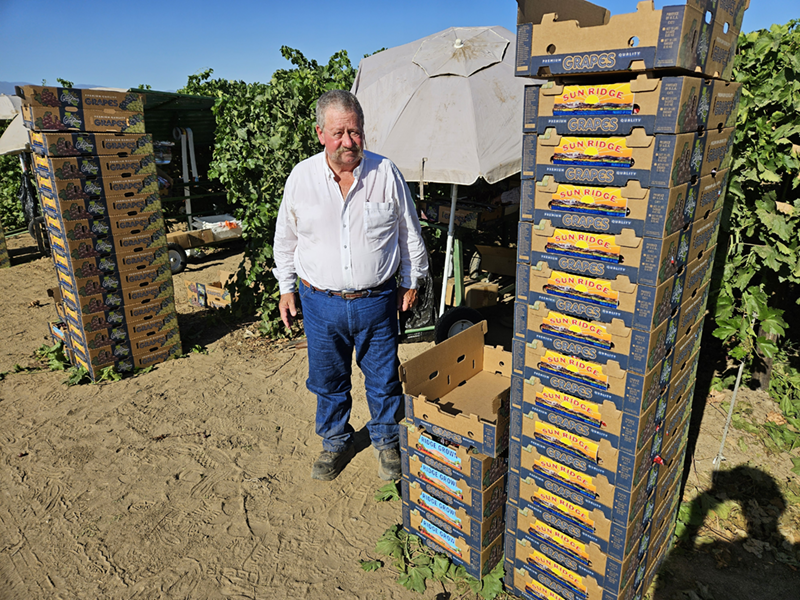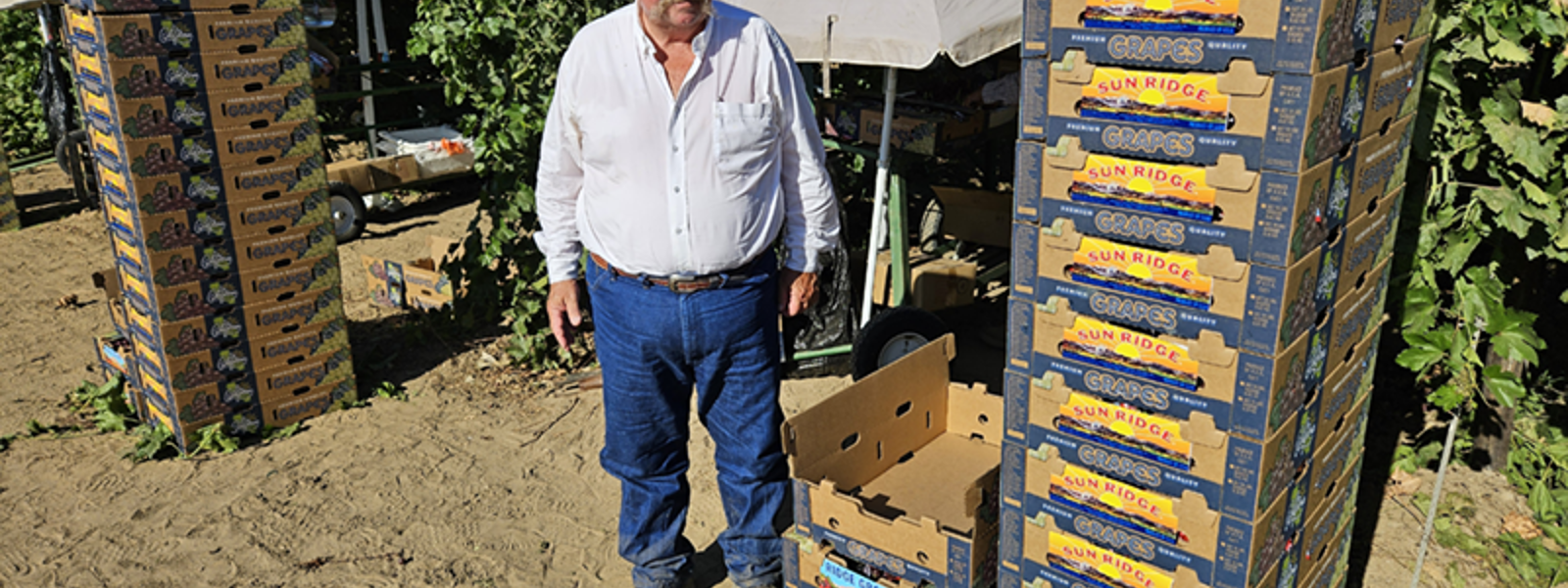Heat wave messes with table grape harvest, volumes

Kern County grower Mark Hall stands in a vineyard earlier this month during harvest of Flame Seedless grapes. He says the state’s unrelenting heat wave has begun to damage some varieties.
Photo/Sal Ruedas

By Ching Lee
The prolonged heat wave has slowed the supply of California table grapes, with vines shutting down and picking crews working fewer hours just as the state’s main growing region ramps up harvest.
San Joaquin Valley growers, who produce most of the nation’s fresh-market grapes, say the excessive heat has begun to damage some varieties while inhibiting growth of others. Pickers have been working mostly six-hour shifts in the morning to avoid sweltering afternoon temperatures, leaving fruit on the vine, as they can’t pick it all.
“It’s just taking longer to pick it,” said Kern County grower Mark Hall.
Temperatures soared to triple digits just as the region began harvest in early July. Though some of Hall’s early Flame Seedless were fine, he said the extended heat spell is now affecting quality. Overripe fruit that didn’t get picked on time turned mushy and melted. His Sugraone grapes—a greenish-yellow seedless variety—may be a total loss due to heat damage and mildew, which weakens the skin and causes the berries to crack and rot. Autumn King, another light-green variety, shows some sunburn.
With other valley growers in the same boat, Hall said there’s not as much fruit on the market, which has helped prices. In more typical years, prices tend to drop in the middle of summer and rise later in the season as supplies wane.
Mexico has had its own production problems, shortening its shipping season. That means there’s been less imported fruit lingering in domestic markets as California inventories came online, said Jim Beagle, CEO of Shafter-based Grapery, which grows table grapes in Kern and Tulare counties. This has resulted in “much smoother supply-and-demand dynamics” compared to the big price swings and crashes seen last year, he added.
California table grape acreage reached 125,000 in 2023, down from 127,000 acres in 2022, according to the U.S. Department of Agriculture. That’s compared to 610,000 acres of winegrapes in 2023 and 138,000 acres grown for raisins in 2021.
Harvest in the San Joaquin Valley typically runs through December, with cold-storage grapes available into January. The Coachella Valley produces some early-season fruit beginning in mid- to late May, with harvest wrapping up as the San Joaquin Valley starts.
California table grape volumes also took a hit last year after a rare tropical storm battered San Joaquin Valley vineyards during peak harvest.
Beagle said his company lost about 25% of its crop. The cost of saving the remaining 75% was exorbitant, he said, because it was all done by hand. Rain-cracked fruit had to be trimmed individually, he said, and as the berries collapsed, rot spread through the bunches, which had to be cleaned out.
“It was the biggest detrimental financial event to ever hit the California table grape industry,” Beagle said. “We also lost a lot of yield.”
With supplies tight after the storm, prices shot up “a fair amount,” he said, as U.S. retailers “recognized the dire situation for the industry.”
This year, even with impacts from the heat, Beagle said production costs remain manageable, with prices “off to a reasonable start.” Growers have also been blessed with two consecutive years of improved water supplies, he added.
While it’s still early in the season, Beagle said he remains optimistic, noting his crop “looks great” so far. The heat has put stress on some varieties that are just finishing, he said, but most of the crop is still ways off from being harvested, allowing it to better withstand the heat. Also, with drip irrigation, newer heat-tolerant varieties and modern trellis systems that allow leaf canopies to shade and protect the fruit from direct sunlight, he said growers can manage extended heat periods far better today.
“Overall, I don’t see (the heat) having a major impact on the quality or size of the California table grape crop,” Beagle said.
Beagle’s company markets its grapes with names such as Cotton Candy, Gum Drops, Moon Drops and Tear Drops, with the first two referring to the grapes’ candy-like flavors and the other two named for their elongated shapes. Except for Cotton Candy, which mimics the taste of the carnival confection, Beagle said the other grapes are not variety names. Multiple varieties go into grapes marketed as Gum Drops, for example.
“We provide these names as a way for consumers to connect with the experience that they get out of the grapes,” he said.
The company continues to test different varieties from breeding programs that are releasing grapes with flavors such as grape soda and grape lollipop, and some of them will be added to Grapery’s lineup, Beagle said.
“They all have little differences, but they all have these grape candy-like flavors,” he said.
Kern County grower Chris Ramirez, who works for Blanc Vineyards in Delano, said the candy varieties are popular with shoppers and sell well, but they tend to be more labor-intensive and expensive to pick. Because their fruit sizes are smaller compared to more traditional varieties such as Flame Seedless or Autumn King, more bunches are needed to fill a bag.
“People have to work a little bit more and harvest more crop to get a box,” he said.
While retailers want the latest trendy varieties and growers want to supply buyers, Ramirez said farmers are also careful about not overplanting and must consider whether certain varieties work well from a production standpoint. He recalled how the farm planted more acres of Krissy, a red seedless variety, due to demand from “a specific consumer market.”
“Turns out, this variety is very sensitive to heat. When it starts maturing, you’ve got a four-day window to pick before it turns soft,” he said, noting the farm has since regrafted those vines to a different variety.
Of the state’s 10 most popular table-grape varieties in 2023 by acreage, nine are seedless, five are red, four are green or light green, and one is blue-black—Autumn Royal, at No. 7. With 12,163 acres last year, Flame Seedless remains the leading table grape variety in California. The early-season red grape is usually the first major variety harvested each year.
The seeded Red Globe ranks No. 5, with 5,281 acres. Once widely grown, the large-sized grape is less common in U.S. markets. Because of its firm flesh and it holds up well, it is now grown mostly for export.
Beagle of Grapery said his company does not market any of its grapes as seedless, pointing out that the so-called seedless varieties are not truly seedless. They contain traces of a seed that’s either underdeveloped, partially aborted or completely aborted. The small specks are soft and often undetectable, but they can start to lignify once the berries mature fully, forming a texture that’s almost seed-like, he said.
“It’s not really a seed,” Beagle said, “but for a purist in terms of seedlessness, it’s not completely seedless either.”
(Ching Lee is an assistant editor of Ag Alert. She may be contacted at clee@cfbf.com.)




